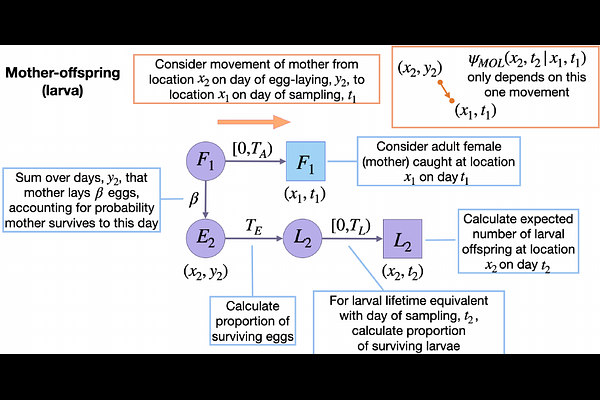Spatial close-kin mark-recapture methods to estimate dispersal parameters and barrier strength for mosquitoes

Spatial close-kin mark-recapture methods to estimate dispersal parameters and barrier strength for mosquitoes
Marshall, J. M.; Yang, S.; Bennett, J. B.; Filipovic, I.; Rasic, G.
AbstractClose-kin mark-recapture (CKMR) methods have recently been used to infer demographic parameters for several aquatic and terrestrial species. For mosquitoes, the spatial distribution of close-kin pairs has been used to estimate mean dispersal distance, of relevance to vector-borne disease transmission and genetic biocontrol strategies. Close-kin methods have advantages over traditional mark-release-recapture (MRR) methods as the mark is genetic, removing the need for physical marking and recapturing that may interfere with movement behavior. Here, we extend CKMR methods to accommodate spatial structure alongside life history for mosquitoes and comparable insects. We derive kinship probabilities for parent-offspring and full-sibling pairs in a spatial context, where an individual in each pair may be a larva or adult. Using the dengue vector Aedes aegypti as a case study, we use an individual-based model of mosquito life history to test the effectiveness of this approach at estimating parameters such as mean dispersal distance, daily staying probability, and the strength of a barrier to movement. Considering a simulated population of 9,025 adult mosquitoes arranged on a 19-by-19 grid, we find the CKMR approach provides unbiased and precise estimates of mean dispersal distance given a total of 2,500 adult females sampled over a three-month period using 25 traps evenly spread throughout the landscape. The CKMR approach is also able to estimate parameters of more complex dispersal kernels, such as the daily staying probability of a zero-inflated exponential kernel, or the strength of a barrier to movement, provided the magnitude of these parameters is greater than 0.5. These results suggest that CKMR provides an insightful characterization of mosquito dispersal that is complementary to conventional MRR methods.